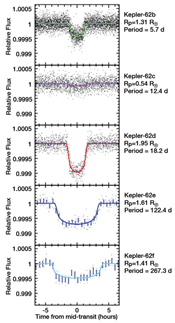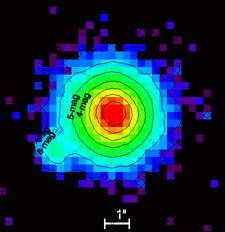Researchers close to finding habitable planets
Researchers from the Niels Bohr Institute and Aarhus University are part of a team that has discovered a planetary system with five small planets of which two are super-Earth sized and lie in the habitable zone. The discovery was made by the NASA Kepler satellite. The results are published in the scientific journal, Science.

Light curves of the five planets orbiting the star Kepler-62. The dip in the light curve occur when the planet moves in front of the host star, thereby dimming the light of the star. The dip in the light curve is proportional to the size of the planet. The two light curves at the bottom of the plot are of the planets in the habitable zone, Kepler-62e and Kepler-62f.
“It’s the closest we’ve come to finding habitable planets,” explains astrophysicist Lars A. Buchhave from the Niels Bohr Institute and Centre for Star and Planet Formation at the University of Copenhagen.
The five planets are all small planets with a radius of between ½ and 2 times the Earth’s radius. The three innermost planets have orbital periods of 5, 12 and 58 days, respectively, so their years are very short and they are extremely hot.
Planets in the habitable zone
“The two outermost planets, called Kepler-62e and Kepler-62f, have orbital periods of 122 and 267 days, respectively, and they are located in a very interesting area. If the innermost planet had an atmosphere like the Earth, it would have a temperature of approximately 30 C and the outermost would have a temperature of -32 C. That is in the habitable zone with the potential for life,” explains Lars A. Buchhave.
By comparison, our planet Earth would have a temperature of -18 C if it did not have an atmosphere and has a temperature of 15 C with an atmosphere, since the atmosphere acts as a shield that traps the heat from the Sun.
Small star with a long lifespan
The Kepler mission is comprised of an international team that has discovered and classified this interesting planetary system and Denmark is heavily involved in the research.

A high resolution image of the host star Kepler-62 taken with the Keck I telescope on Hawaii. The images shows that there are no bright stars in the near proximity of the host star (except for a very faint star to the east of the target star).
“We have studied the physical characteristics of the star and we can conclude that it is a dwarf star that is only 20 percent as bright as our Sun. So the two outermost planets, which otherwise lie relatively close to the star, have temperatures that would allow for flowing water to exist on their surface,” explains Hans Kjeldsen, Associate Professor at the Stellar Astrophysics Centre, Department of Physics and Astronomy, Aarhus University. He explains that the star is approximately 1,200 light years away, so for an astronomer it is almost in our neighbourhood in the Milky Way.
But the researchers do not know whether the two planets, Kepler-62e and Kepler-62f are solid rocky planets or gas giants. “We know their size – they are 1,6 and 1,4 times the size of the Earth, respectively, but we do not know their mass, so we cannot say what they are comprised of. The light from the star is simply too weak for us to measure their mass, i.e. their weight,” says Lars A. Buchhave.
By studying the star’s spectrum, Lars A. Buchhave has determined its chemical composition. He discovered that it has close to the same chemical composition as the Sun, but not quite as many heavy elements. Because the stars and planets are formed in the same process, the planetary system that has just been found has many similarities to our solar system.

An artist’s impression of the Kepler-62 exoplanet system compared with our own Solar System. At the top is shown the five planets in the Kepler-62, where the leftmost planets, Kepler-62e og Kepler-62f, are in the habitable zone. (NASA)
Another similarity with our solar system is the star’s lifespan. Small stars live longer than large stars, as they do not burn out as quickly. By measuring how fast the star rotates, one can calculate how long it has lived. In the course of a star’s lifetime the rotation slows and researchers have calculated that the star has lived 7 billion years – giving it plenty of time for life to have developed.
It is not known whether the planets are solid rocky planets and whether they have an atmosphere. Current telescopes are unable to answer these questions. So the researchers are very much looking forward to the launch of NASA's TESS Mission in 2017 as well as for the expected completion of the world’s largest telescope, the E-ELT, in 2023 on the top of Cerro Armazones in Chile, which will allow them to find and observe the planets. For the first time they will be able to see details of the planets’ atmospheres and reveal whether they may be affected by biological activity.
Rich potential for life
There are 300 billion stars in the Milky Way and approximately 80 percent of them are smaller stars – so-called red dwarves that have long lifespans. Recent research has shown that approximately 16 percent of them have planets in the habitable zone – just in the Milky Way. If the conditions are there, there could be rich potential for life everywhere.
